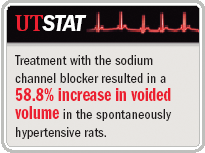Article
Five compounds show potential in OAB, pain syndromes
Atlanta-Five new compounds-none an antimuscarinic and all in different classes-are showing potential for overactive bladder. They may also have applications in BPH, chronic prostatitis/chronic pelvic pain syndrome, and painful bladder syndrome/interstitial cystitis (PBS/IC).
Atlanta-Five new compounds-none an antimuscarinic and all in different classes-are showing potential for overactive bladder. They may also have applications in BPH, chronic prostatitis/chronic pelvic pain syndrome, and painful bladder syndrome/interstitial cystitis (PBS/IC).
Researchers described their basic re-search on a cannabinoid, a calcitriol analog, an ATP-sensitive potassium channel opener, a sodium channel blocker, and a combined 5HT3 receptor antagonist and noradrenaline reuptake inhibitor (NARI) here at the AUA annual meeting.
The cannabinoid, ajulemic acid, which reduced bladder contractions and increased pressure thresholds, will likely find its main application in PBS/IC (see Urology Times, June 2006).

Elocalcitol has a number of different actions. It inhibits inflammation and cell proliferation, showing potential for BPH, but it also inhibits a signaling pathway in bladder smooth muscle. The RhoA/Rho kinase (ROK) pathway is considered a major intracellular pathway for activation of the M3 muscarinic receptor in bladder contraction. This pathway is upregulated in OAB.
The study Dr. Maggi presented at the meeting looked at the compound's effects on ROK activity in human bladder cells in vitro, on ROK activity in the bladders of rats genetically prone to OAB, on bladder contractions induced by a bladder irritant in normal rats, and on bladder cell migration.
In the in vitro experiments, human bladder cells were treated with endothelin-1, an inducer of RhoA activity. Western Blot showed added elocalcitol inhibited the RhoA activation and membrane translocation. Under the microscope, bladder cells activated by endothelin-1 showed actin-dependent cytoskeletal remodeling, but this was blunted when elocalcitol was added. Elocalcitol also inhibited the migration of bladder cells induced by endothelin-1.
Spontaneously hypertensive (SH) rats overexpress the RhoA/ROK pathway and develop overactive bladder, but elocalcitol reduced ROK activity in their bladders. The bladders of these rats responded little to Y27632, an inhibitor of the pathway, but elocalcitol normalized their reaction up to the level in normotensive rats. Normal rat bladders also respond to carbachol with overactivity, but in elocalcitol-treated rats, the response was significantly delayed.
Giuseppe Penna, a research associate at BioXell, the Milan, Italy-based manufacturer of BXL-628, said that a clinical trial in CP/CPPS is ongoing and one in PBS/IC is planned.
Potassium channel opener
ATP-sensitive potassium (KATP) channels have recently been found in a wide variety of tissue, including smooth muscle cells, neurons, and secretory cells. Japanese investigators from the departments of urology and pharmacology at Kyushu University in Fukuoka, are investigating a bladder selective KATP channel opener known as ZD0947.
The compound induced potassium currents in bladder myocytes. It also significantly reduced carbachol-induced contractions in bladder smooth muscle strips. At lower concentrations, it did not do so to guinea pig aortic smooth muscle, demonstrating some selectivity. That indicated that it could be a new tool for OAB management, according to the researchers.
5HT3 receptor antagonists
At research symposia on CP/CPPS and PBS/IC, researchers have speculated on the potential application of 5HT3 receptor antagonists, which include IBS drugs alosetron (Lotronex) and tegaserod (Zelnorm). NARIs, such as venlafaxine (Effexor), are finding a role in pain management, and noradrenaline is known to play a role in lower urinary tract function. For this reason, researchers from Dynogen Pharmaceuticals investigated the combination drug, known as DDP225, which is both a 5HT3 antagonist and a NARI, in rat and cat models of OAB. Matthew O. Fraser, PhD, adjunct assistant professor of urology at Duke University Medical Center and formerly director of in vivo pharmacology at Dynogen when this research was performed, presented the study in Atlanta.
















